People and Organizations: Analysis of IKEA and IOC
VerifiedAdded on 2022/08/10
|15
|2999
|482
Report
AI Summary
This report provides a comprehensive analysis of the organizational structures, cultures, and behaviors within IKEA and Indian Oil Corporation. It explores the structural and cultural differentiation of both companies, examining how these elements influence leadership, management, and employee behavior. The report delves into the impact of organizational structure and culture, considering factors like Hofstede's model of national culture, power distance, and individualism. Furthermore, it identifies and analyzes key drivers of organizational change, such as political, economic, social, technological, and legal factors, specifically focusing on the impact of the Brexit deal on IKEA's operations. The analysis provides insights into the challenges and opportunities faced by these organizations in adapting to changing business environments.
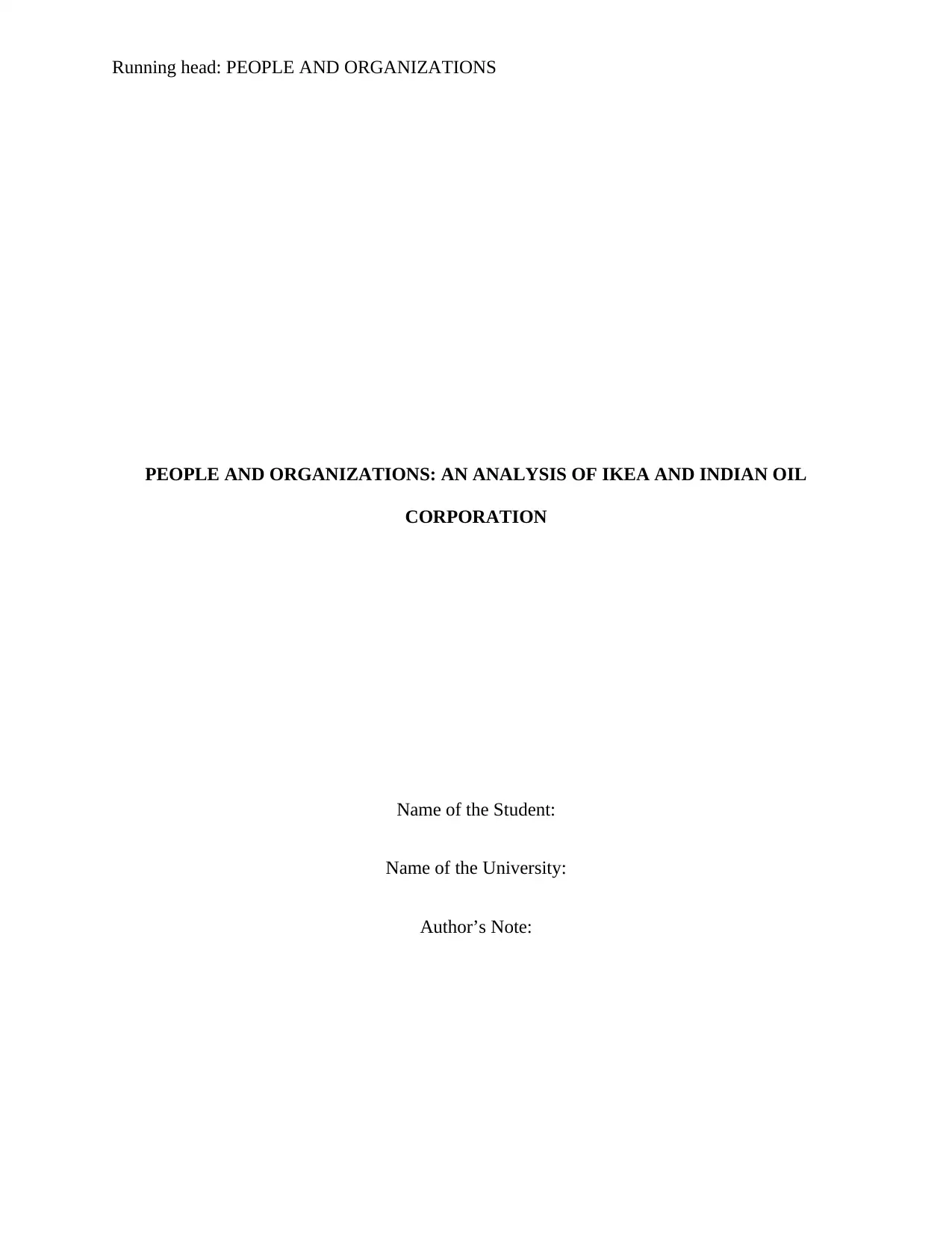
Running head: PEOPLE AND ORGANIZATIONS
PEOPLE AND ORGANIZATIONS: AN ANALYSIS OF IKEA AND INDIAN OIL
CORPORATION
Name of the Student:
Name of the University:
Author’s Note:
PEOPLE AND ORGANIZATIONS: AN ANALYSIS OF IKEA AND INDIAN OIL
CORPORATION
Name of the Student:
Name of the University:
Author’s Note:
Paraphrase This Document
Need a fresh take? Get an instant paraphrase of this document with our AI Paraphraser
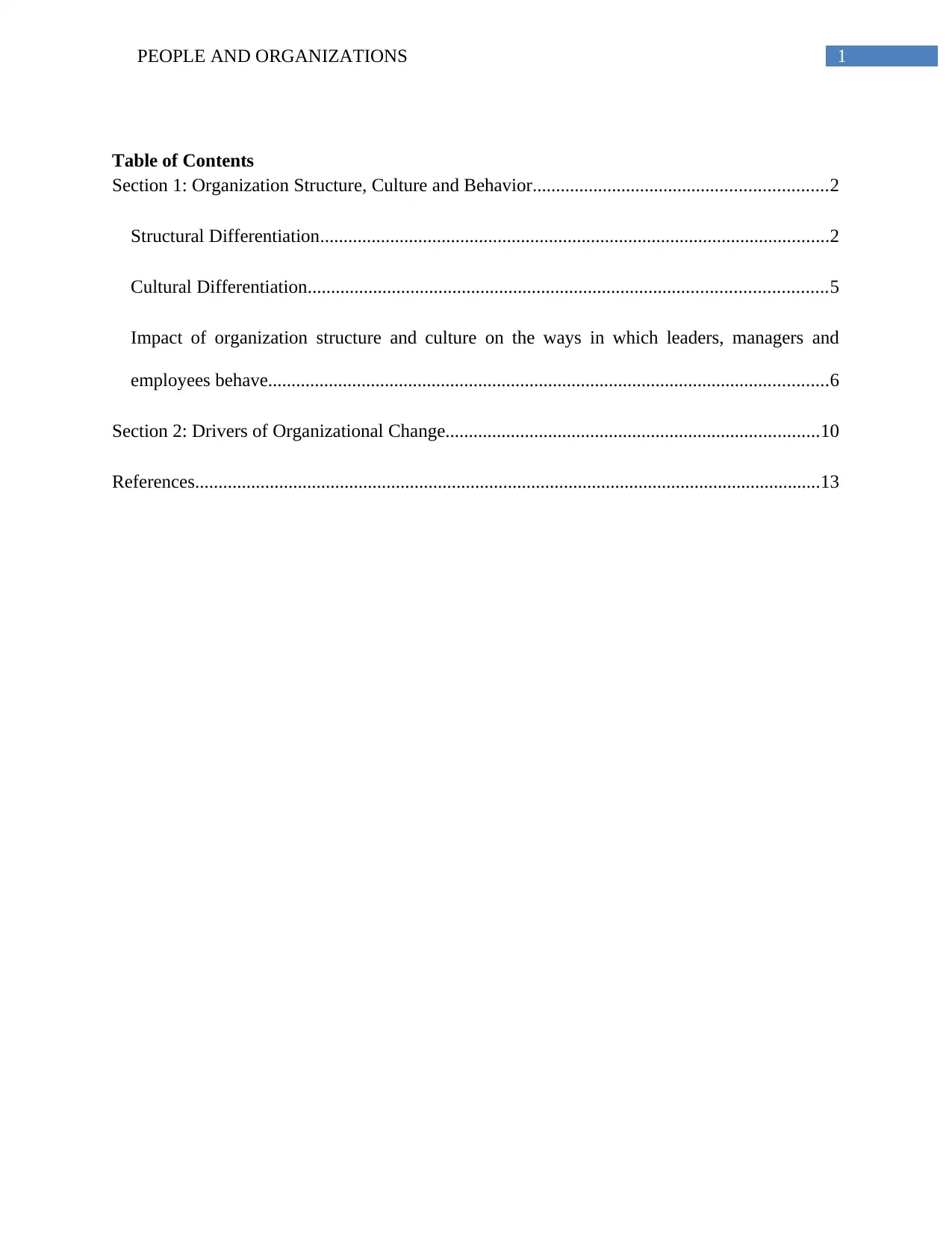
1PEOPLE AND ORGANIZATIONS
Table of Contents
Section 1: Organization Structure, Culture and Behavior...............................................................2
Structural Differentiation.............................................................................................................2
Cultural Differentiation...............................................................................................................5
Impact of organization structure and culture on the ways in which leaders, managers and
employees behave........................................................................................................................6
Section 2: Drivers of Organizational Change................................................................................10
References......................................................................................................................................13
Table of Contents
Section 1: Organization Structure, Culture and Behavior...............................................................2
Structural Differentiation.............................................................................................................2
Cultural Differentiation...............................................................................................................5
Impact of organization structure and culture on the ways in which leaders, managers and
employees behave........................................................................................................................6
Section 2: Drivers of Organizational Change................................................................................10
References......................................................................................................................................13
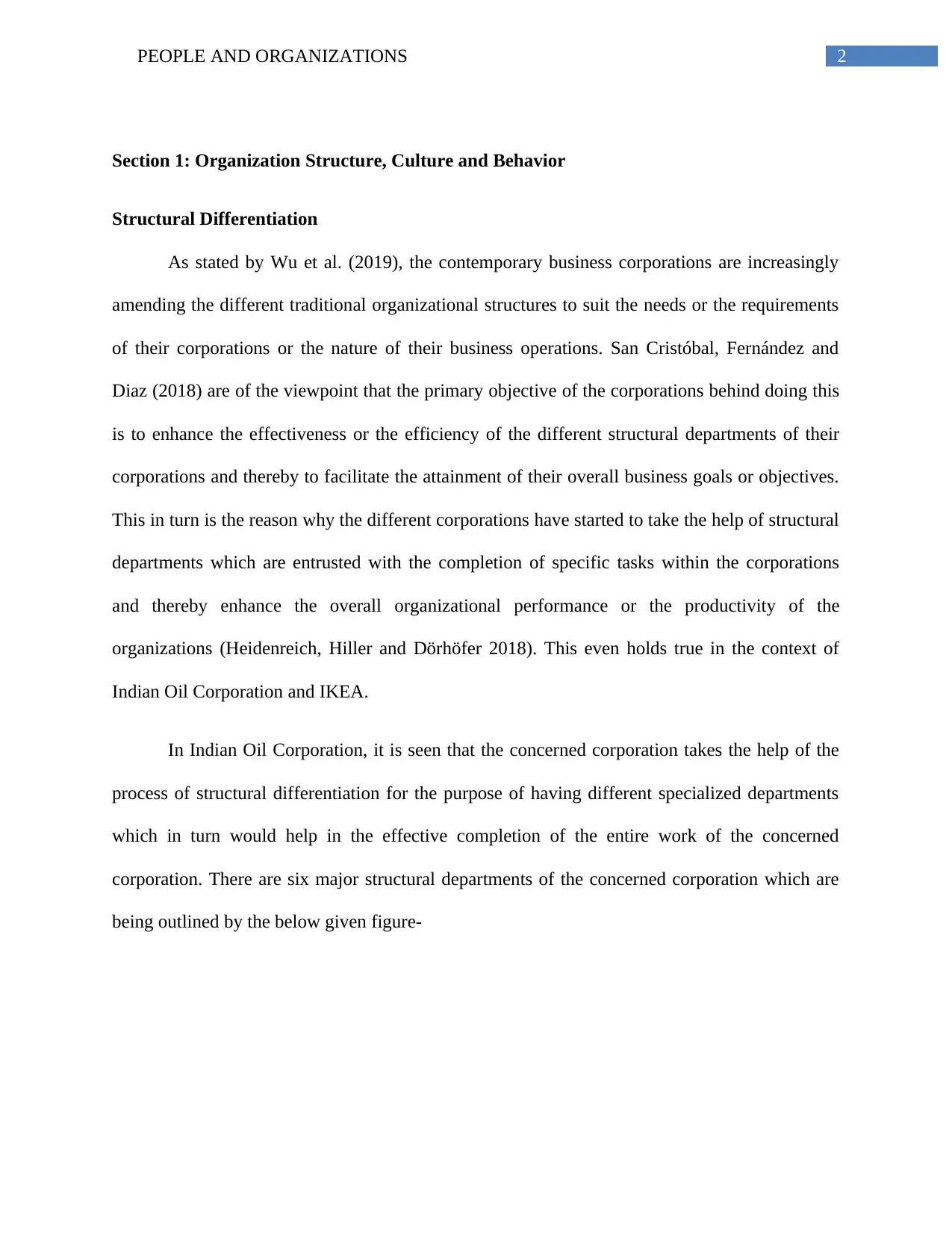
2PEOPLE AND ORGANIZATIONS
Section 1: Organization Structure, Culture and Behavior
Structural Differentiation
As stated by Wu et al. (2019), the contemporary business corporations are increasingly
amending the different traditional organizational structures to suit the needs or the requirements
of their corporations or the nature of their business operations. San Cristóbal, Fernández and
Diaz (2018) are of the viewpoint that the primary objective of the corporations behind doing this
is to enhance the effectiveness or the efficiency of the different structural departments of their
corporations and thereby to facilitate the attainment of their overall business goals or objectives.
This in turn is the reason why the different corporations have started to take the help of structural
departments which are entrusted with the completion of specific tasks within the corporations
and thereby enhance the overall organizational performance or the productivity of the
organizations (Heidenreich, Hiller and Dörhöfer 2018). This even holds true in the context of
Indian Oil Corporation and IKEA.
In Indian Oil Corporation, it is seen that the concerned corporation takes the help of the
process of structural differentiation for the purpose of having different specialized departments
which in turn would help in the effective completion of the entire work of the concerned
corporation. There are six major structural departments of the concerned corporation which are
being outlined by the below given figure-
Section 1: Organization Structure, Culture and Behavior
Structural Differentiation
As stated by Wu et al. (2019), the contemporary business corporations are increasingly
amending the different traditional organizational structures to suit the needs or the requirements
of their corporations or the nature of their business operations. San Cristóbal, Fernández and
Diaz (2018) are of the viewpoint that the primary objective of the corporations behind doing this
is to enhance the effectiveness or the efficiency of the different structural departments of their
corporations and thereby to facilitate the attainment of their overall business goals or objectives.
This in turn is the reason why the different corporations have started to take the help of structural
departments which are entrusted with the completion of specific tasks within the corporations
and thereby enhance the overall organizational performance or the productivity of the
organizations (Heidenreich, Hiller and Dörhöfer 2018). This even holds true in the context of
Indian Oil Corporation and IKEA.
In Indian Oil Corporation, it is seen that the concerned corporation takes the help of the
process of structural differentiation for the purpose of having different specialized departments
which in turn would help in the effective completion of the entire work of the concerned
corporation. There are six major structural departments of the concerned corporation which are
being outlined by the below given figure-
⊘ This is a preview!⊘
Do you want full access?
Subscribe today to unlock all pages.

Trusted by 1+ million students worldwide
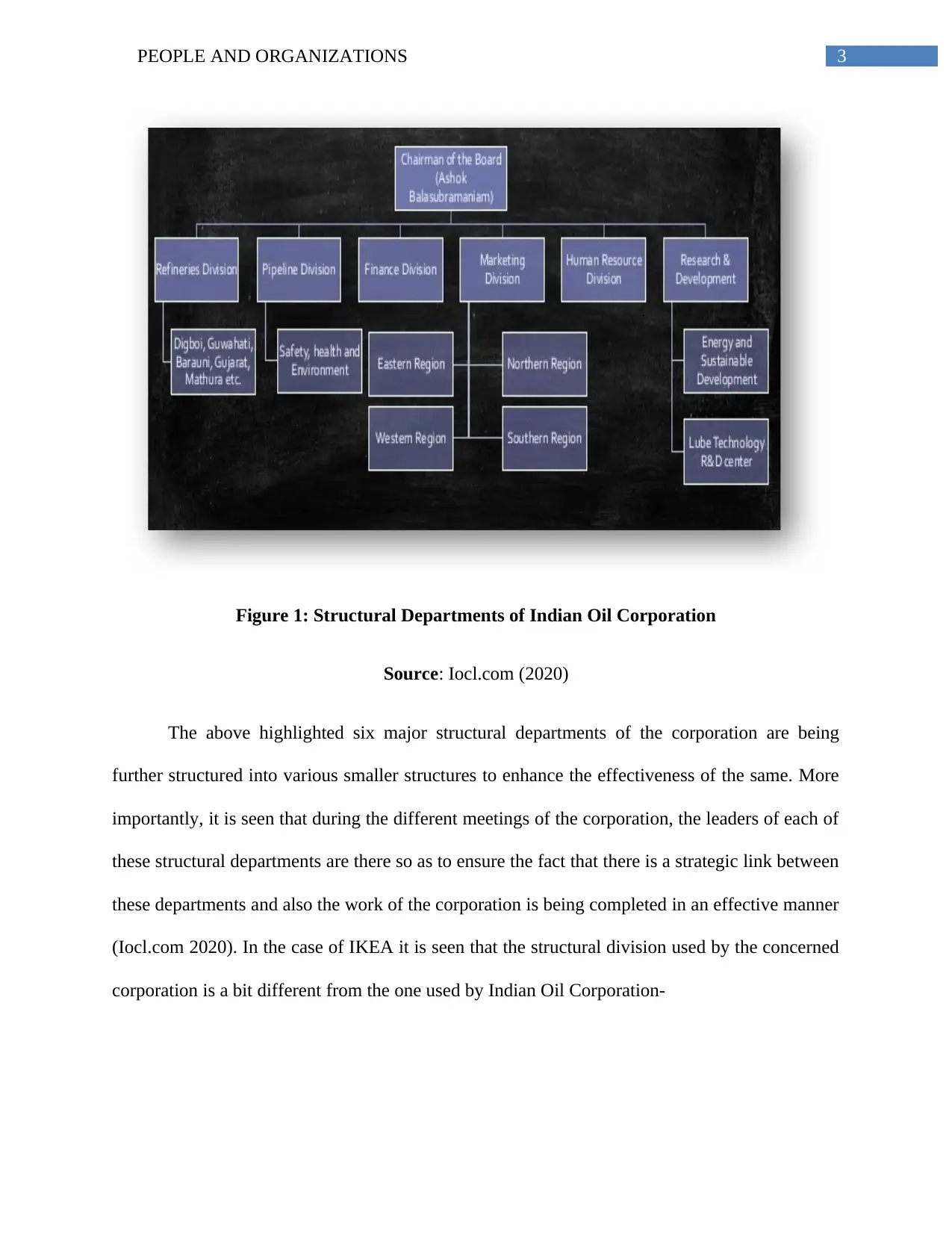
3PEOPLE AND ORGANIZATIONS
Figure 1: Structural Departments of Indian Oil Corporation
Source: Iocl.com (2020)
The above highlighted six major structural departments of the corporation are being
further structured into various smaller structures to enhance the effectiveness of the same. More
importantly, it is seen that during the different meetings of the corporation, the leaders of each of
these structural departments are there so as to ensure the fact that there is a strategic link between
these departments and also the work of the corporation is being completed in an effective manner
(Iocl.com 2020). In the case of IKEA it is seen that the structural division used by the concerned
corporation is a bit different from the one used by Indian Oil Corporation-
Figure 1: Structural Departments of Indian Oil Corporation
Source: Iocl.com (2020)
The above highlighted six major structural departments of the corporation are being
further structured into various smaller structures to enhance the effectiveness of the same. More
importantly, it is seen that during the different meetings of the corporation, the leaders of each of
these structural departments are there so as to ensure the fact that there is a strategic link between
these departments and also the work of the corporation is being completed in an effective manner
(Iocl.com 2020). In the case of IKEA it is seen that the structural division used by the concerned
corporation is a bit different from the one used by Indian Oil Corporation-
Paraphrase This Document
Need a fresh take? Get an instant paraphrase of this document with our AI Paraphraser
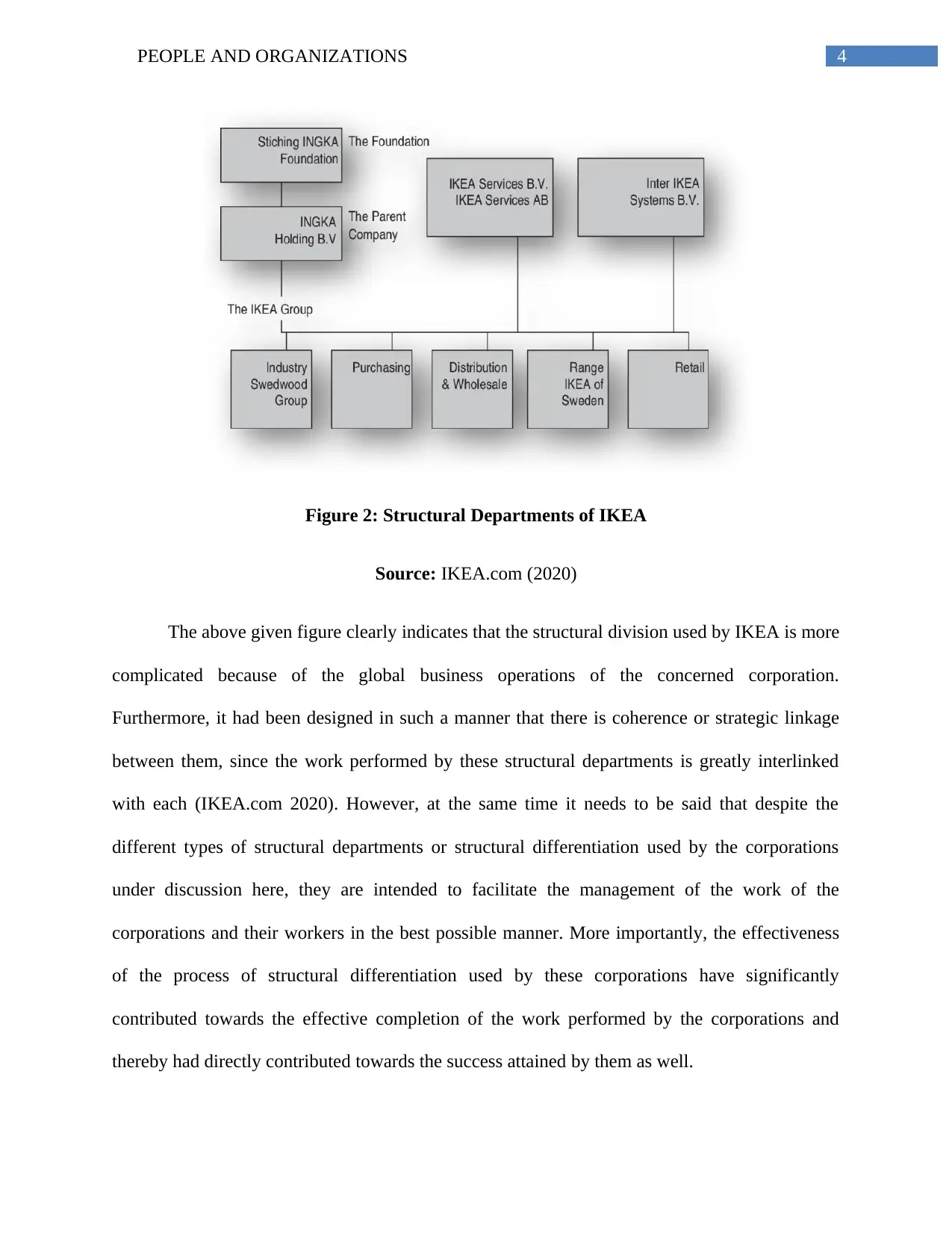
4PEOPLE AND ORGANIZATIONS
Figure 2: Structural Departments of IKEA
Source: IKEA.com (2020)
The above given figure clearly indicates that the structural division used by IKEA is more
complicated because of the global business operations of the concerned corporation.
Furthermore, it had been designed in such a manner that there is coherence or strategic linkage
between them, since the work performed by these structural departments is greatly interlinked
with each (IKEA.com 2020). However, at the same time it needs to be said that despite the
different types of structural departments or structural differentiation used by the corporations
under discussion here, they are intended to facilitate the management of the work of the
corporations and their workers in the best possible manner. More importantly, the effectiveness
of the process of structural differentiation used by these corporations have significantly
contributed towards the effective completion of the work performed by the corporations and
thereby had directly contributed towards the success attained by them as well.
Figure 2: Structural Departments of IKEA
Source: IKEA.com (2020)
The above given figure clearly indicates that the structural division used by IKEA is more
complicated because of the global business operations of the concerned corporation.
Furthermore, it had been designed in such a manner that there is coherence or strategic linkage
between them, since the work performed by these structural departments is greatly interlinked
with each (IKEA.com 2020). However, at the same time it needs to be said that despite the
different types of structural departments or structural differentiation used by the corporations
under discussion here, they are intended to facilitate the management of the work of the
corporations and their workers in the best possible manner. More importantly, the effectiveness
of the process of structural differentiation used by these corporations have significantly
contributed towards the effective completion of the work performed by the corporations and
thereby had directly contributed towards the success attained by them as well.
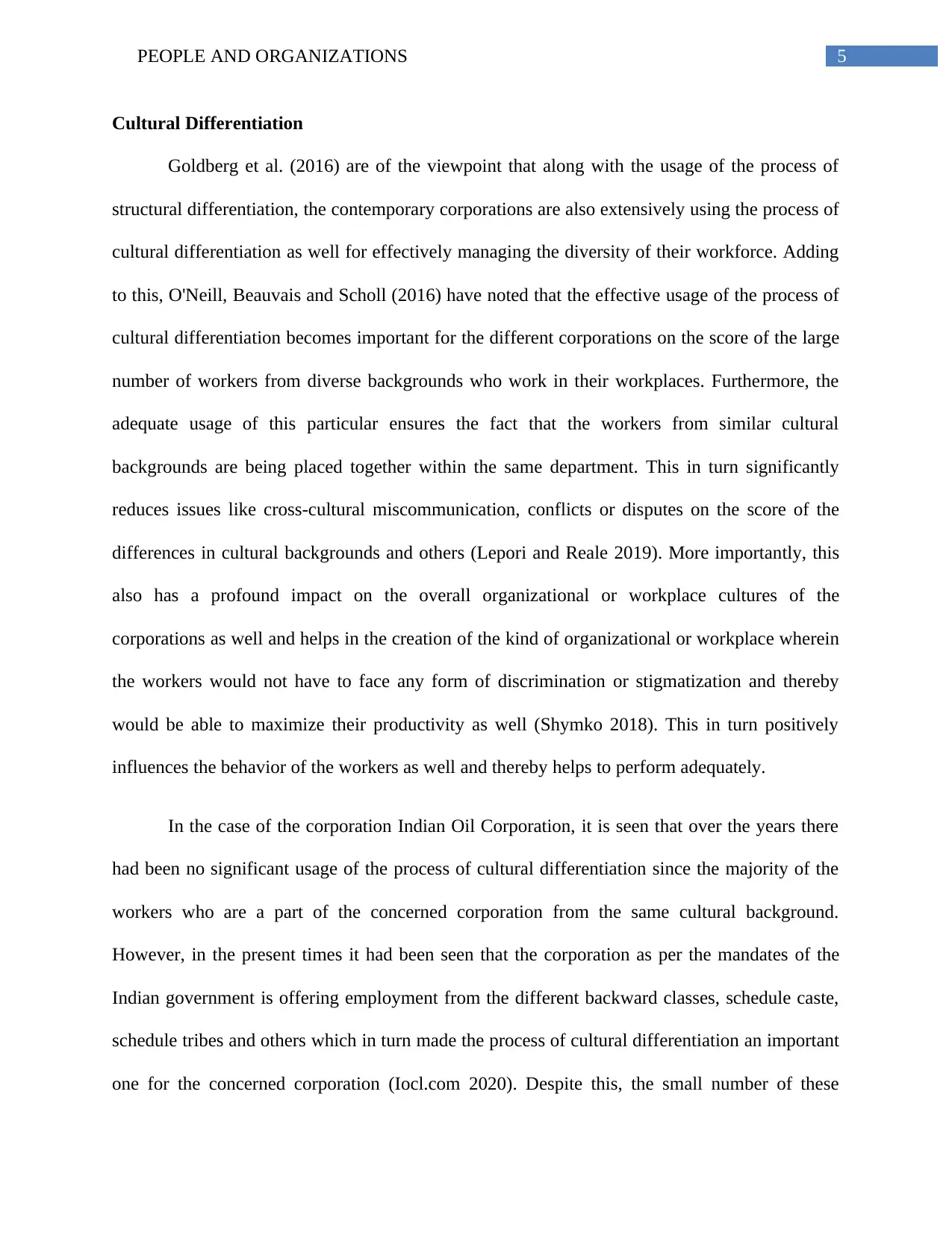
5PEOPLE AND ORGANIZATIONS
Cultural Differentiation
Goldberg et al. (2016) are of the viewpoint that along with the usage of the process of
structural differentiation, the contemporary corporations are also extensively using the process of
cultural differentiation as well for effectively managing the diversity of their workforce. Adding
to this, O'Neill, Beauvais and Scholl (2016) have noted that the effective usage of the process of
cultural differentiation becomes important for the different corporations on the score of the large
number of workers from diverse backgrounds who work in their workplaces. Furthermore, the
adequate usage of this particular ensures the fact that the workers from similar cultural
backgrounds are being placed together within the same department. This in turn significantly
reduces issues like cross-cultural miscommunication, conflicts or disputes on the score of the
differences in cultural backgrounds and others (Lepori and Reale 2019). More importantly, this
also has a profound impact on the overall organizational or workplace cultures of the
corporations as well and helps in the creation of the kind of organizational or workplace wherein
the workers would not have to face any form of discrimination or stigmatization and thereby
would be able to maximize their productivity as well (Shymko 2018). This in turn positively
influences the behavior of the workers as well and thereby helps to perform adequately.
In the case of the corporation Indian Oil Corporation, it is seen that over the years there
had been no significant usage of the process of cultural differentiation since the majority of the
workers who are a part of the concerned corporation from the same cultural background.
However, in the present times it had been seen that the corporation as per the mandates of the
Indian government is offering employment from the different backward classes, schedule caste,
schedule tribes and others which in turn made the process of cultural differentiation an important
one for the concerned corporation (Iocl.com 2020). Despite this, the small number of these
Cultural Differentiation
Goldberg et al. (2016) are of the viewpoint that along with the usage of the process of
structural differentiation, the contemporary corporations are also extensively using the process of
cultural differentiation as well for effectively managing the diversity of their workforce. Adding
to this, O'Neill, Beauvais and Scholl (2016) have noted that the effective usage of the process of
cultural differentiation becomes important for the different corporations on the score of the large
number of workers from diverse backgrounds who work in their workplaces. Furthermore, the
adequate usage of this particular ensures the fact that the workers from similar cultural
backgrounds are being placed together within the same department. This in turn significantly
reduces issues like cross-cultural miscommunication, conflicts or disputes on the score of the
differences in cultural backgrounds and others (Lepori and Reale 2019). More importantly, this
also has a profound impact on the overall organizational or workplace cultures of the
corporations as well and helps in the creation of the kind of organizational or workplace wherein
the workers would not have to face any form of discrimination or stigmatization and thereby
would be able to maximize their productivity as well (Shymko 2018). This in turn positively
influences the behavior of the workers as well and thereby helps to perform adequately.
In the case of the corporation Indian Oil Corporation, it is seen that over the years there
had been no significant usage of the process of cultural differentiation since the majority of the
workers who are a part of the concerned corporation from the same cultural background.
However, in the present times it had been seen that the corporation as per the mandates of the
Indian government is offering employment from the different backward classes, schedule caste,
schedule tribes and others which in turn made the process of cultural differentiation an important
one for the concerned corporation (Iocl.com 2020). Despite this, the small number of these
⊘ This is a preview!⊘
Do you want full access?
Subscribe today to unlock all pages.

Trusted by 1+ million students worldwide
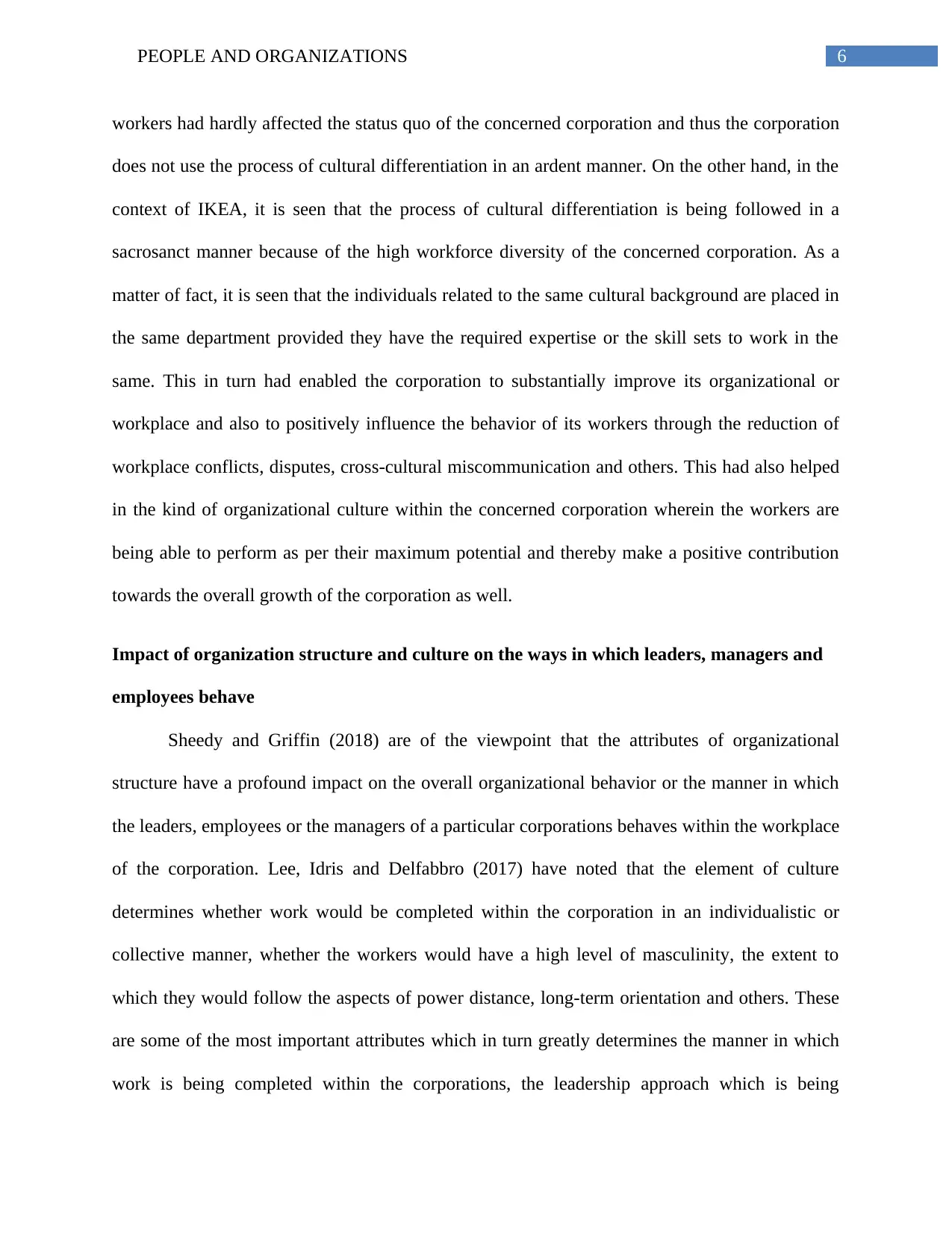
6PEOPLE AND ORGANIZATIONS
workers had hardly affected the status quo of the concerned corporation and thus the corporation
does not use the process of cultural differentiation in an ardent manner. On the other hand, in the
context of IKEA, it is seen that the process of cultural differentiation is being followed in a
sacrosanct manner because of the high workforce diversity of the concerned corporation. As a
matter of fact, it is seen that the individuals related to the same cultural background are placed in
the same department provided they have the required expertise or the skill sets to work in the
same. This in turn had enabled the corporation to substantially improve its organizational or
workplace and also to positively influence the behavior of its workers through the reduction of
workplace conflicts, disputes, cross-cultural miscommunication and others. This had also helped
in the kind of organizational culture within the concerned corporation wherein the workers are
being able to perform as per their maximum potential and thereby make a positive contribution
towards the overall growth of the corporation as well.
Impact of organization structure and culture on the ways in which leaders, managers and
employees behave
Sheedy and Griffin (2018) are of the viewpoint that the attributes of organizational
structure have a profound impact on the overall organizational behavior or the manner in which
the leaders, employees or the managers of a particular corporations behaves within the workplace
of the corporation. Lee, Idris and Delfabbro (2017) have noted that the element of culture
determines whether work would be completed within the corporation in an individualistic or
collective manner, whether the workers would have a high level of masculinity, the extent to
which they would follow the aspects of power distance, long-term orientation and others. These
are some of the most important attributes which in turn greatly determines the manner in which
work is being completed within the corporations, the leadership approach which is being
workers had hardly affected the status quo of the concerned corporation and thus the corporation
does not use the process of cultural differentiation in an ardent manner. On the other hand, in the
context of IKEA, it is seen that the process of cultural differentiation is being followed in a
sacrosanct manner because of the high workforce diversity of the concerned corporation. As a
matter of fact, it is seen that the individuals related to the same cultural background are placed in
the same department provided they have the required expertise or the skill sets to work in the
same. This in turn had enabled the corporation to substantially improve its organizational or
workplace and also to positively influence the behavior of its workers through the reduction of
workplace conflicts, disputes, cross-cultural miscommunication and others. This had also helped
in the kind of organizational culture within the concerned corporation wherein the workers are
being able to perform as per their maximum potential and thereby make a positive contribution
towards the overall growth of the corporation as well.
Impact of organization structure and culture on the ways in which leaders, managers and
employees behave
Sheedy and Griffin (2018) are of the viewpoint that the attributes of organizational
structure have a profound impact on the overall organizational behavior or the manner in which
the leaders, employees or the managers of a particular corporations behaves within the workplace
of the corporation. Lee, Idris and Delfabbro (2017) have noted that the element of culture
determines whether work would be completed within the corporation in an individualistic or
collective manner, whether the workers would have a high level of masculinity, the extent to
which they would follow the aspects of power distance, long-term orientation and others. These
are some of the most important attributes which in turn greatly determines the manner in which
work is being completed within the corporations, the leadership approach which is being
Paraphrase This Document
Need a fresh take? Get an instant paraphrase of this document with our AI Paraphraser
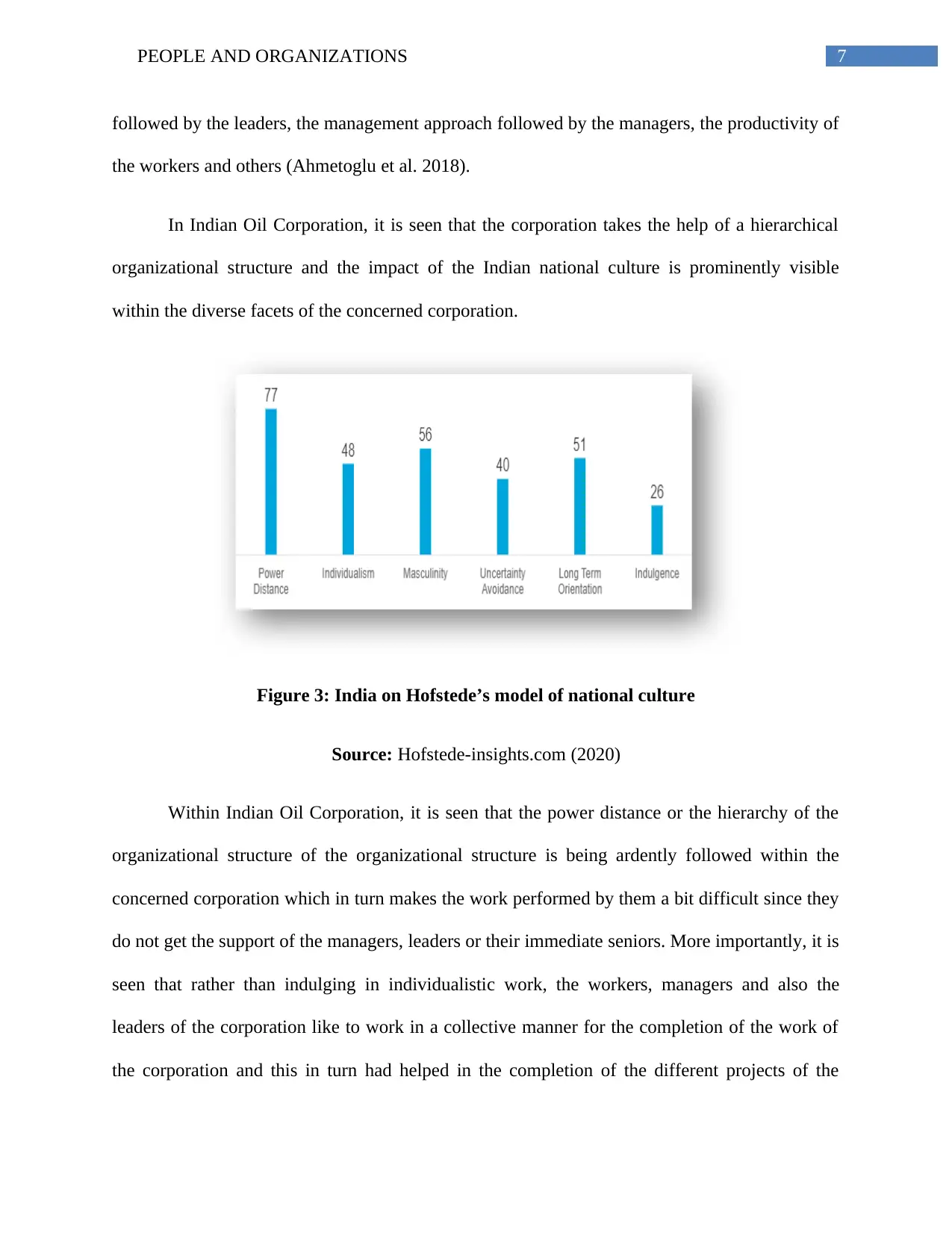
7PEOPLE AND ORGANIZATIONS
followed by the leaders, the management approach followed by the managers, the productivity of
the workers and others (Ahmetoglu et al. 2018).
In Indian Oil Corporation, it is seen that the corporation takes the help of a hierarchical
organizational structure and the impact of the Indian national culture is prominently visible
within the diverse facets of the concerned corporation.
Figure 3: India on Hofstede’s model of national culture
Source: Hofstede-insights.com (2020)
Within Indian Oil Corporation, it is seen that the power distance or the hierarchy of the
organizational structure of the organizational structure is being ardently followed within the
concerned corporation which in turn makes the work performed by them a bit difficult since they
do not get the support of the managers, leaders or their immediate seniors. More importantly, it is
seen that rather than indulging in individualistic work, the workers, managers and also the
leaders of the corporation like to work in a collective manner for the completion of the work of
the corporation and this in turn had helped in the completion of the different projects of the
followed by the leaders, the management approach followed by the managers, the productivity of
the workers and others (Ahmetoglu et al. 2018).
In Indian Oil Corporation, it is seen that the corporation takes the help of a hierarchical
organizational structure and the impact of the Indian national culture is prominently visible
within the diverse facets of the concerned corporation.
Figure 3: India on Hofstede’s model of national culture
Source: Hofstede-insights.com (2020)
Within Indian Oil Corporation, it is seen that the power distance or the hierarchy of the
organizational structure of the organizational structure is being ardently followed within the
concerned corporation which in turn makes the work performed by them a bit difficult since they
do not get the support of the managers, leaders or their immediate seniors. More importantly, it is
seen that rather than indulging in individualistic work, the workers, managers and also the
leaders of the corporation like to work in a collective manner for the completion of the work of
the corporation and this in turn had helped in the completion of the different projects of the
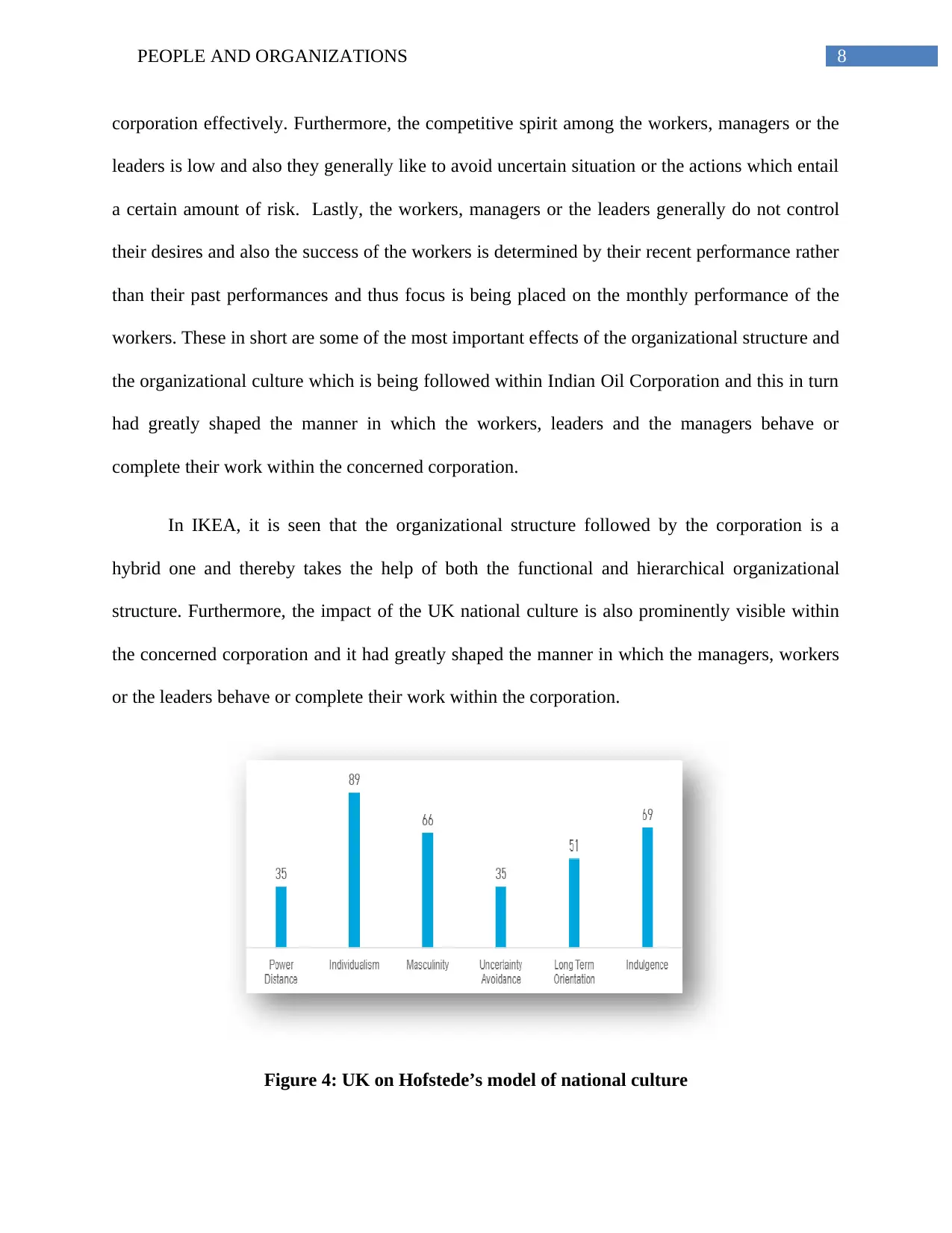
8PEOPLE AND ORGANIZATIONS
corporation effectively. Furthermore, the competitive spirit among the workers, managers or the
leaders is low and also they generally like to avoid uncertain situation or the actions which entail
a certain amount of risk. Lastly, the workers, managers or the leaders generally do not control
their desires and also the success of the workers is determined by their recent performance rather
than their past performances and thus focus is being placed on the monthly performance of the
workers. These in short are some of the most important effects of the organizational structure and
the organizational culture which is being followed within Indian Oil Corporation and this in turn
had greatly shaped the manner in which the workers, leaders and the managers behave or
complete their work within the concerned corporation.
In IKEA, it is seen that the organizational structure followed by the corporation is a
hybrid one and thereby takes the help of both the functional and hierarchical organizational
structure. Furthermore, the impact of the UK national culture is also prominently visible within
the concerned corporation and it had greatly shaped the manner in which the managers, workers
or the leaders behave or complete their work within the corporation.
Figure 4: UK on Hofstede’s model of national culture
corporation effectively. Furthermore, the competitive spirit among the workers, managers or the
leaders is low and also they generally like to avoid uncertain situation or the actions which entail
a certain amount of risk. Lastly, the workers, managers or the leaders generally do not control
their desires and also the success of the workers is determined by their recent performance rather
than their past performances and thus focus is being placed on the monthly performance of the
workers. These in short are some of the most important effects of the organizational structure and
the organizational culture which is being followed within Indian Oil Corporation and this in turn
had greatly shaped the manner in which the workers, leaders and the managers behave or
complete their work within the concerned corporation.
In IKEA, it is seen that the organizational structure followed by the corporation is a
hybrid one and thereby takes the help of both the functional and hierarchical organizational
structure. Furthermore, the impact of the UK national culture is also prominently visible within
the concerned corporation and it had greatly shaped the manner in which the managers, workers
or the leaders behave or complete their work within the corporation.
Figure 4: UK on Hofstede’s model of national culture
⊘ This is a preview!⊘
Do you want full access?
Subscribe today to unlock all pages.

Trusted by 1+ million students worldwide
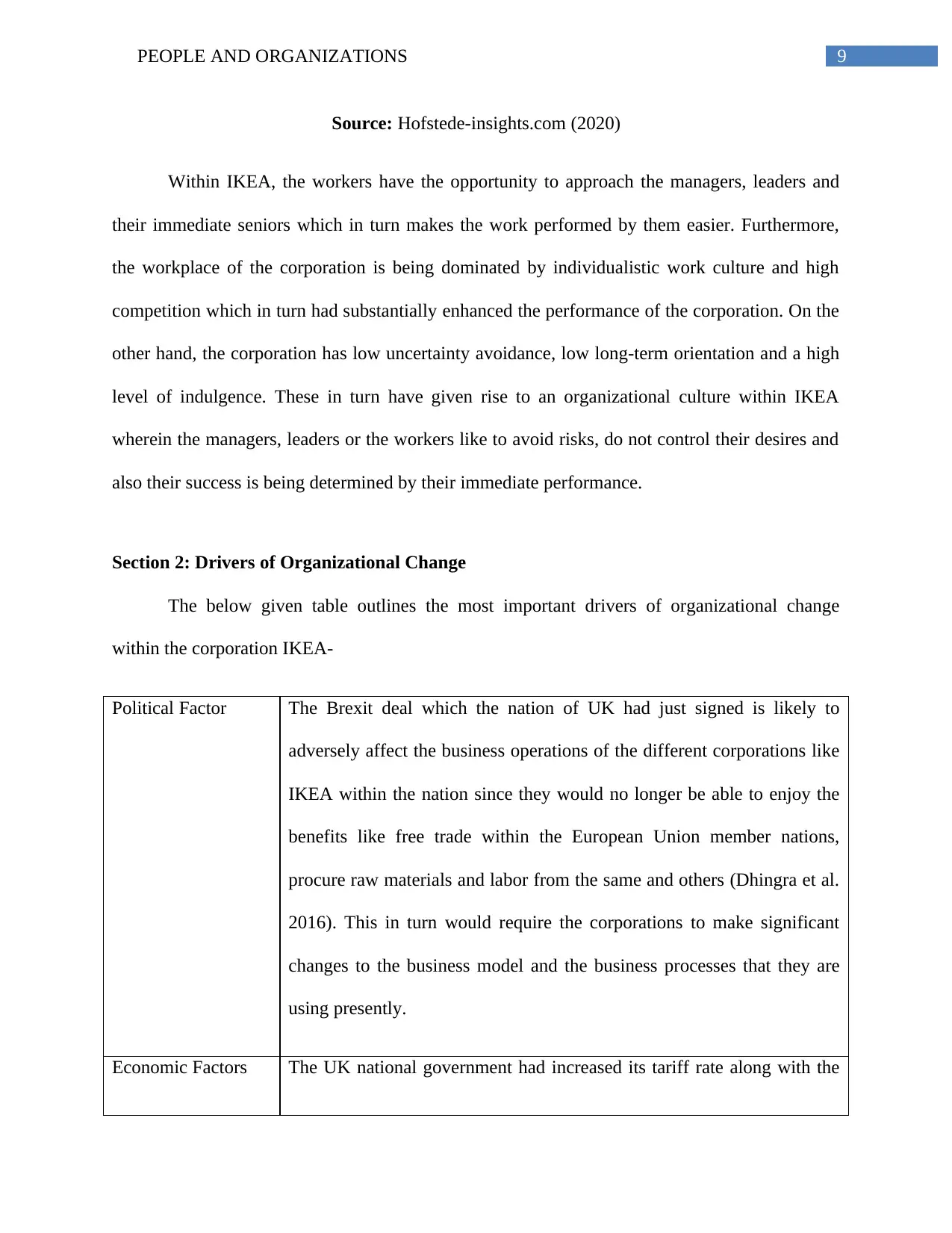
9PEOPLE AND ORGANIZATIONS
Source: Hofstede-insights.com (2020)
Within IKEA, the workers have the opportunity to approach the managers, leaders and
their immediate seniors which in turn makes the work performed by them easier. Furthermore,
the workplace of the corporation is being dominated by individualistic work culture and high
competition which in turn had substantially enhanced the performance of the corporation. On the
other hand, the corporation has low uncertainty avoidance, low long-term orientation and a high
level of indulgence. These in turn have given rise to an organizational culture within IKEA
wherein the managers, leaders or the workers like to avoid risks, do not control their desires and
also their success is being determined by their immediate performance.
Section 2: Drivers of Organizational Change
The below given table outlines the most important drivers of organizational change
within the corporation IKEA-
Political Factor The Brexit deal which the nation of UK had just signed is likely to
adversely affect the business operations of the different corporations like
IKEA within the nation since they would no longer be able to enjoy the
benefits like free trade within the European Union member nations,
procure raw materials and labor from the same and others (Dhingra et al.
2016). This in turn would require the corporations to make significant
changes to the business model and the business processes that they are
using presently.
Economic Factors The UK national government had increased its tariff rate along with the
Source: Hofstede-insights.com (2020)
Within IKEA, the workers have the opportunity to approach the managers, leaders and
their immediate seniors which in turn makes the work performed by them easier. Furthermore,
the workplace of the corporation is being dominated by individualistic work culture and high
competition which in turn had substantially enhanced the performance of the corporation. On the
other hand, the corporation has low uncertainty avoidance, low long-term orientation and a high
level of indulgence. These in turn have given rise to an organizational culture within IKEA
wherein the managers, leaders or the workers like to avoid risks, do not control their desires and
also their success is being determined by their immediate performance.
Section 2: Drivers of Organizational Change
The below given table outlines the most important drivers of organizational change
within the corporation IKEA-
Political Factor The Brexit deal which the nation of UK had just signed is likely to
adversely affect the business operations of the different corporations like
IKEA within the nation since they would no longer be able to enjoy the
benefits like free trade within the European Union member nations,
procure raw materials and labor from the same and others (Dhingra et al.
2016). This in turn would require the corporations to make significant
changes to the business model and the business processes that they are
using presently.
Economic Factors The UK national government had increased its tariff rate along with the
Paraphrase This Document
Need a fresh take? Get an instant paraphrase of this document with our AI Paraphraser
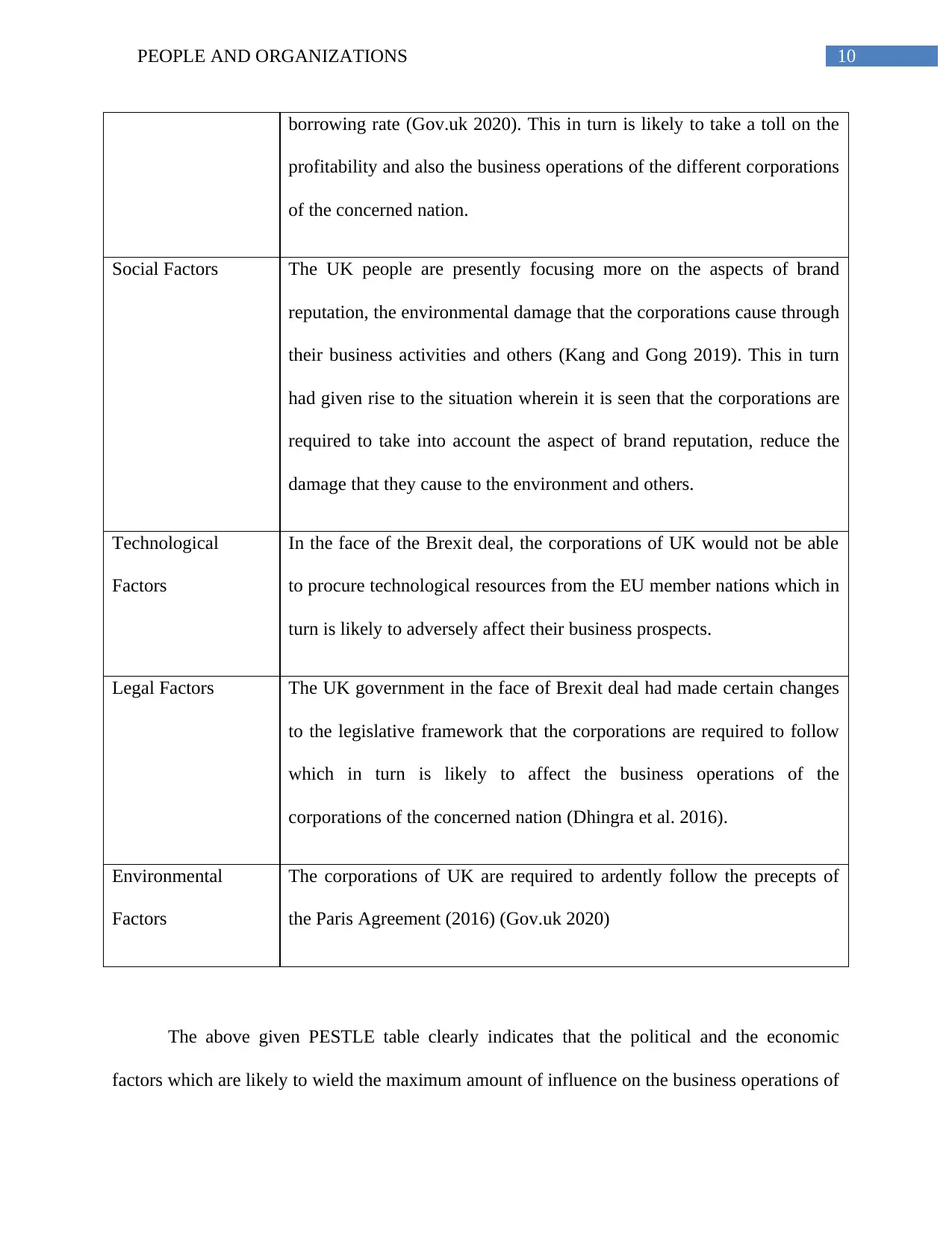
10PEOPLE AND ORGANIZATIONS
borrowing rate (Gov.uk 2020). This in turn is likely to take a toll on the
profitability and also the business operations of the different corporations
of the concerned nation.
Social Factors The UK people are presently focusing more on the aspects of brand
reputation, the environmental damage that the corporations cause through
their business activities and others (Kang and Gong 2019). This in turn
had given rise to the situation wherein it is seen that the corporations are
required to take into account the aspect of brand reputation, reduce the
damage that they cause to the environment and others.
Technological
Factors
In the face of the Brexit deal, the corporations of UK would not be able
to procure technological resources from the EU member nations which in
turn is likely to adversely affect their business prospects.
Legal Factors The UK government in the face of Brexit deal had made certain changes
to the legislative framework that the corporations are required to follow
which in turn is likely to affect the business operations of the
corporations of the concerned nation (Dhingra et al. 2016).
Environmental
Factors
The corporations of UK are required to ardently follow the precepts of
the Paris Agreement (2016) (Gov.uk 2020)
The above given PESTLE table clearly indicates that the political and the economic
factors which are likely to wield the maximum amount of influence on the business operations of
borrowing rate (Gov.uk 2020). This in turn is likely to take a toll on the
profitability and also the business operations of the different corporations
of the concerned nation.
Social Factors The UK people are presently focusing more on the aspects of brand
reputation, the environmental damage that the corporations cause through
their business activities and others (Kang and Gong 2019). This in turn
had given rise to the situation wherein it is seen that the corporations are
required to take into account the aspect of brand reputation, reduce the
damage that they cause to the environment and others.
Technological
Factors
In the face of the Brexit deal, the corporations of UK would not be able
to procure technological resources from the EU member nations which in
turn is likely to adversely affect their business prospects.
Legal Factors The UK government in the face of Brexit deal had made certain changes
to the legislative framework that the corporations are required to follow
which in turn is likely to affect the business operations of the
corporations of the concerned nation (Dhingra et al. 2016).
Environmental
Factors
The corporations of UK are required to ardently follow the precepts of
the Paris Agreement (2016) (Gov.uk 2020)
The above given PESTLE table clearly indicates that the political and the economic
factors which are likely to wield the maximum amount of influence on the business operations of
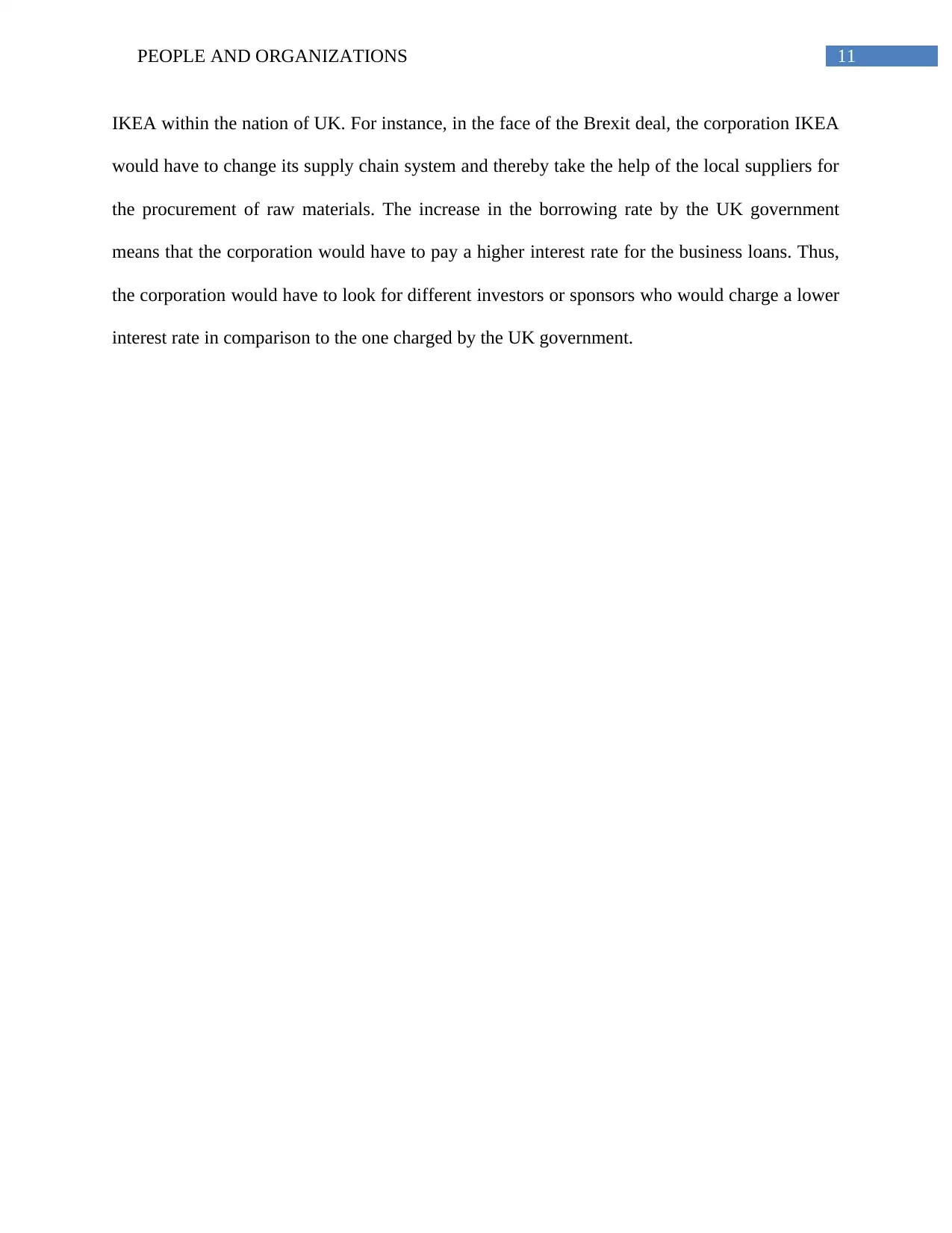
11PEOPLE AND ORGANIZATIONS
IKEA within the nation of UK. For instance, in the face of the Brexit deal, the corporation IKEA
would have to change its supply chain system and thereby take the help of the local suppliers for
the procurement of raw materials. The increase in the borrowing rate by the UK government
means that the corporation would have to pay a higher interest rate for the business loans. Thus,
the corporation would have to look for different investors or sponsors who would charge a lower
interest rate in comparison to the one charged by the UK government.
IKEA within the nation of UK. For instance, in the face of the Brexit deal, the corporation IKEA
would have to change its supply chain system and thereby take the help of the local suppliers for
the procurement of raw materials. The increase in the borrowing rate by the UK government
means that the corporation would have to pay a higher interest rate for the business loans. Thus,
the corporation would have to look for different investors or sponsors who would charge a lower
interest rate in comparison to the one charged by the UK government.
⊘ This is a preview!⊘
Do you want full access?
Subscribe today to unlock all pages.

Trusted by 1+ million students worldwide
1 out of 15
Related Documents
Your All-in-One AI-Powered Toolkit for Academic Success.
+13062052269
info@desklib.com
Available 24*7 on WhatsApp / Email
![[object Object]](/_next/static/media/star-bottom.7253800d.svg)
Unlock your academic potential
Copyright © 2020–2025 A2Z Services. All Rights Reserved. Developed and managed by ZUCOL.





